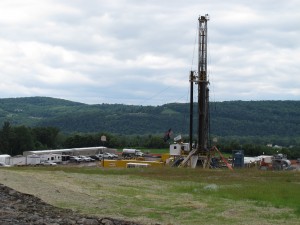New study links gas drilling to water contamination in NE Pa.
-
Susan Phillips
New research published today in the Proceedings of the National Academy of Sciences shows evidence of a connection between gas drilling and water contamination that occurred in Bradford County in 2010. The researchers used a new method of testing for contaminants that can detect much smaller amounts of chemicals than the instruments typically used in commercial laboratories.
“[It’s] probably the most equipped technique to find a problem like this,” said Frank Dorman, a professor of biochemistry at Penn State University and one of the authors of the study. “It can see lower down than many techniques and it can see a wider variety and more complex samples than other techniques. It could be a game changer. We found something that wasn’t findable by commercial laboratories.”
The report could point to a new tool for those who believe they have suffered from gas drilling contamination, only to have water tests say otherwise.
The instrument Dorman used in his lab at Penn State to test the drinking water samples in the study is called a comprehensive 2D gas chromatography coupled to time-of-flight mass spectrometry (GCxGC-TOFMS).
The results of the tests showed levels of the chemical 2-n-Butoxyethanol, or 2-BE, as well as unresolved complex mixtures (UCMs). Previous tests by both the Department of Environmental Protection and environmental consultants using traditional laboratory methods did not show these chemicals. Dorman says the chemical 2-BE is used as a surfactant in drilling fluid and marketed under the product name Airfoam HD. The UCM signatures also matched sampled Marcellus Shale flowback fluid that Dorman had tested using this same method.
Dorman and the researchers on the paper are quick to point out that the contamination happened before the wells were hydraulically fractured, and could be traced either to poor well construction or the leakage of an impoundment pit that contained drilling fluid. The contamination did not occur as a result of frack fluid migrating from the Marcellus Shale upward, the report says.

Susan Phillips / WHYY
Billboard in Bradford County Pennsylvania taken in August 2010 advertises Chesapeake Energy’s support of a local health facility.
The research focused on three homes in southeastern Bradford County, along Paradise Road in Wyalusing. Families began complaining of sediment in their well water soon after the construction of a Marcellus Shale gas well by Chesapeake Energy in the spring of 2010. Later tests revealed high levels of methane in the well water, one of which was at explosive levels and required evacuation. That summer Chesapeake had to dig up and fix several gas wells. In the meantime the company provided potable water. Chesapeake then dug new water wells for the homeowners, which did not alleviate the problems.
The Department of Environmental Protection subsequently found Chesapeake responsible and fined the company. Chesapeake ended up purchasing the houses from the three families, and settled the case for $1.6 million. The three families moved away.
But one mystery remained.
Residents also experienced foamy water, which when tested by several different labs did not reveal any contaminants that could account for the foam.
Garth Llewellyn, a hydrogeologist hired by one of the families along Paradise Road, found that perplexing.
“If you look at water like that, that’s not natural,” said Llewellyn. “And the fact that you can analyze for a standard list of [compounds] and they come back fine, that’s a bit concerning to me. And if I lived at this property, I wouldn’t have drank the water. And I’m a hydrogeologist.”
So Llewellyn teamed up with researchers at Penn State, including Dorman, to investigate. And what they found, the 2-BE and the hydrocarbons, linked not to the deep hydro-fracking itself, but to earlier stages of the gas drilling process.
“We can say with confidence that gas migration happens,” said Llewellyn. “These [water] wells were impacted by natural gas, and we’re finding signatures that are very similar to frack flowback samples that Dorman collected.”
The new method can detect chemicals at parts per trillion, rather than the typical parts per billion or parts per million. The researchers also used a different method than the typical water sample test recommended by the Environmental Protection Agency, which sets protocols on what to test for, and what levels are considered a public health threat.
“It allows us to look at broad signatures instead of target compounds like 2-BE, benzene, or toluene,” said Llewellyn. “That’s important because essentially if you have a predefined list [of targeted chemicals] and you go out into the field and sample for it, but you have no prior knowledge of what was spilled, your target analysis may or may not be applicable to whatever the issue is.”
Llewellyn says their study looks at the issue comprehensively, and examines a body of evidence. For example, methane began to bubble out of the nearby Susquehanna river in ten different spots soon after drilling began. Once the wells were remediated, the bubbling stopped.
“The point of the paper is emphasizing the use of multiple lines of evidence and then looking at the forest rather than getting lost in the trees,” he said.
Llewellyn has consulted on a number of possible shale gas related water troubles for residents. And like health professionals in the area, has plenty of anecdotal stories of people exhibiting similar symptoms they think may be linked, like skin lesions. But Llewellyn is not a toxicologist, and so says he can’t come to any conclusions regarding the health impacts of these levels of toxins.
“We really don’t know and that’s what really needs to be studied,” he said.
Researchers also took samples from nearby homes where residents did not report problems with their drinking water, and did not find any of the chemicals found in the impacted wells.
Penn State professor Frank Dorman says one problem with the EPA’s protocols is that it’s designed around remediation, not discovery. So it’s a challenge to do analyses for new industrial processes.
“I think this instrument should have a home in the EPA or DEP labs where people are looking for the bigger picture,” he said. “What’s in there, what’s making it not right? Let’s look for a wide range of contaminants even though they are not current targets of some EPA protocol.”
The Department of Environmental Protection has issued 835 violations to Chesapeake Energy, the majority are in Bradford and Susquehanna counties. Chesapeake declined to comment on the paper.
The authors of the study did not receive any major research grants or funding.

















